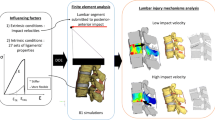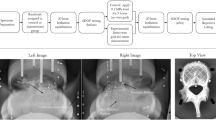Abstract
Anterior longitudinal ligament (ALL) injuries following whiplash have been documented both in vivo and in vitro; however, ALL strains during the whiplash trauma remain unknown. A new in vitro whiplash model and a bench-top trauma sled were used in an incremental trauma protocol to simulate whiplash at 3.5, 5, 6.5 and 8 g accelerations, and peak ALL strains were determined for each trauma. Following the final trauma, the ALLs were inspected and classified as uninjured, partially injured or completely injured. Peak strain, peak intervertebral extension and increases in flexibility parameters were compared among the three injury classification groups. Peak ALL strains were largest in the lower cervical spine, and increased with impact acceleration, reaching a maximum of 29.3% at C6-C7 at 8 g. Significant increases (P<0.05) over the physiological strain limits first occurred at C4-C5 during the 3.5 g trauma and spread to lower intervertebral levels as impact severity increased. The complete ligament injuries were associated with greater increases in ALL strain, intervertebral extension, and flexibility parameters than were observed at uninjured intervertebral levels (P<0.05).





Similar content being viewed by others
References
Barnsley L, Lord S, Bogduk N (1994) Whiplash injury. Pain 58:283–307
Braakman R, Penning L (1971) Injuries of the cervical spine. Excerpta Medica, Amsterdam
Bunketorp L, Nordholm L, Carlsson J (2002) A descriptive analysis of disorders in patients 17 years following motor vehicle accidents. Eur Spine J 11:227–234
Buonocore E, Hartman JT, Nelson CL (1966) Cineradiograms of cervical spine in diagnosis of soft-tissue injuries. JAMA 198:143–147
Butler D, Trafimow JH, Andersson GB, McNeill TW, Huckman MS (1990) Discs degenerate before facets. Spine 15:111–113
Cholewicki J, Panjabi MM, Nibu K, et al (1998) Head kinematics during in vitro whiplash simulation. Accid Anal Prev 30:469–479
Cusick JF, Pintar FA, Yoganandan N (2001) Whiplash syndrome: kinematic factors influencing pain patterns. Spine 26:1252–1258
Davis SJ, Teresi LM, Bradley WG Jr, Ziemba MA, Bloze AE (1991) Cervical spine hyperextension injuries: MR findings. Radiology 180:245–251
Dunlop RB, Adams MA, Hutton WC (1984) Disc space narrowing and the lumbar facet joints. J Bone Joint Surg Br 66:706–710
Dvorak J, Panjabi MM, Novotny JE, Antinnes JA (1991) In vivo flexion/extension of the normal cervical spine. J Orthop Res 9:828–834
Fujiwara A, Tamai K, Yamato M, et al (1999) The relationship between facet joint osteoarthritis and disc degeneration of the lumbar spine: an MRI study. Eur Spine J 8:396–401
Grauer JN, Panjabi MM, Cholewicki J, Nibu K, Dvorak J (1997) Whiplash produces an S-shaped curvature of the neck with hyperextension at lower levels. Spine 22:2489–2494
Hampton D, Laros G, McCarron R, Franks D (1989) Healing potential of the anulus fibrosus. Spine 14:398–401
Herkowitz HN, Rothman RH (1984) Subacute instability of the cervical spine. Spine 9:348–357
Ivancic PC, Panjabi M, Ito S, Cripton PA, Wang JL (2002) A biofidelic osteoligamentous cervical spine model with muscle force replication for whiplash trauma simulation. Proceedings of the Cervical Spine Research Society. Miami, December 5–7
Jonsson H Jr, Bring G, Rauschning W, Sahlstedt B (1991) Hidden cervical spine injuries in traffic accident victims with skull fractures. J Spinal Disord 4:251–263
Kaapa E, Han X, Holm S, et al (1995) Collagen synthesis and types I, III, IV, and VI collagens in an animal model of disc degeneration. Spine 20:59–66
Kaneoka K, Ono K, Inami S, Yokoi N, Hayashi K (1997) Human cervical spine kinematics during whiplash loading. International Conference on New Frontiers in Biomechanical Engineering. Tokyo, Japan
Kaneoka K, Ono K, Inami S, Hayashi K (1999) Motion analysis of cervical vertebrae during whiplash loading. Spine 24:763–769
Lind B, Sihlbom H, Nordwall A, Malchau H (1989) Normal range of motion of the cervical spine. Arch Phys Med Rehabil 70:692–695
Lord SM, Barnsley L, Wallis BJ, Bogduk N (1996) Chronic cervical zygapophysial joint pain after whiplash. A placebo-controlled prevalence study. Spine 21:1737–1744
MacNab I (1964) Acceleration injuries of the cervical spine. J Bone Joint Surg Am 46:1797–1799
Moore RJ, Crotti TN, Osti OL, Fraser RD, Vernon-Roberts B (1999) Osteoarthrosis of the facet joints resulting from anular rim lesions in sheep lumbar discs. Spine 24:519–525
Ordway NR, Seymour RJ, Donelson RG, Hojnowski LS, Edwards WT (1999) Cervical flexion, extension, protrusion, and retraction. A radiographic segmental analysis. Spine 24:240–247
Oxland TR, Panjabi MM, Southern EP, Duranceau JS (1991) An anatomic basis for spinal instability: a porcine trauma model. J Orthop Res 9:452–462
Panjabi MM (1992) The stabilizing system of the spine. II. Neutral zone and instability hypothesis. J Spinal Disord 5:390–396
Panjabi MM, White AA 3rd, Johnson RM (1975) Cervical spine mechanics as a function of transection of components. J Biomech 8:327–336
Panjabi MM, Duranceau J, Goel V, Oxland T, Takata K (1991) Cervical human vertebrae. Quantitative three-dimensional anatomy of the middle and lower regions. Spine 16:861–869
Panjabi MM, Oxland TR, Parks EH (1991) Quantitative anatomy of cervical spine ligaments. II. Middle and lower cervical spine. J Spinal Disord 4:277–285
Panjabi MM, Oxland TR, Lin RM, McGowen TW (1994) Thoracolumbar burst fracture. A biomechanical investigation of its multidirectional flexibility. Spine 19:578–585
Panjabi MM, Cholewicki J, Nibu K, Babat LB, Dvorak J (1998) Simulation of whiplash trauma using whole cervical spine specimens. Spine 23:17–24
Panjabi MM, Cholewicki J, Nibu K, et al (1998) Mechanism of whiplash injury. Clin Biomech 13:239–249
Panjabi MM, Nibu K, Cholewicki J (1998) Whiplash injuries and the potential for mechanical instability. Eur Spine J 7:484–492
Panjabi MM, Miura T, Cripton PA, et al (2001) Development of a system for in vitro neck muscle force replication in whole cervical spine experiments. Spine 26:2214–2219
Pearson AM, Ivancic PC, Ito S, Panjabi MM (2003) Facet joint kinematics and injury mechanisms during simulated whiplash. Spine (in press)
Penning L (1978) Normal movements of the cervical spine. AJR 130:317–326
Richter M, Otte D, Pohlemann T, Krettek C, Blauth M (2000) Whiplash-type neck distortion in restrained car drivers: frequency, causes and long-term results. Eur Spine J 9:109–117
Richter M, Wilke HJ, Kluger P, Claes L, Puhl W (2000) Load-displacement properties of the normal and injured lower cervical spine in vitro. Eur Spine J 9:104–108
Shea M, Wittenberg RH, Edwards WT, White AA 3rd, Hayes WC (1992) In vitro hyperextension injuries in the human cadaveric cervical spine. J Orthop Res 10:911–916
Spitzer WO, Skovron ML, Salmi LR, et al (1995) Scientific monograph of the Quebec Task Force on Whiplash-Associated Disorders: redefining “whiplash” and its management. Spine 20:1S–73S
Squires B, Gargan MF, Bannister GC (1996) Soft-tissue injuries of the cervical spine: 15-year follow-up. J Bone Joint Surg Br 78:955–957
Sturzenegger M, Radanov BP, Di Stefano G (1995) The effect of accident mechanisms and initial findings on the long-term course of whiplash injury. J Neurol 242:443–449
White AA 3rd, Panjabi MM (1990) Clinical biomechanics of the spine, JB Lipincott, Philadelphia, pp 110
Yoganandan N, Pintar F, Butler J, et al (1989) Dynamic response of human cervical spine ligaments. Spine 14:1102–1110
Yoganandan N, Kumaresan S, Pintar FA (2000) Geometric and mechanical properties of human cervical spine ligaments. J Biomech Eng 122:623–629
Yoganandan N, Cusick JF, Pintar FA, Rao RD (2001) Whiplash injury determination with conventional spine imaging and cryomicrotomy. Spine 26:2443–2448
Author information
Authors and Affiliations
Corresponding author
Additional information
This research was supported by NIH Grant 1 R01 AR45452 1A2 and the Doris Duke Charitable Foundation
Rights and permissions
About this article
Cite this article
Ivancic, P.C., Pearson, A.M., Panjabi, M.M. et al. Injury of the anterior longitudinal ligament during whiplash simulation. Eur Spine J 13, 61–68 (2004). https://doi.org/10.1007/s00586-003-0590-3
Received:
Revised:
Accepted:
Published:
Issue Date:
DOI: https://doi.org/10.1007/s00586-003-0590-3




